While Peace Lilies have attractive foliage, it’s their blossoms that really catch people’s attention. That is why it is always disheartening to get one that does not blossom. So how do you induce flowering in your peace lily? Let’s talk about my secrets for getting more peace lily flowers.
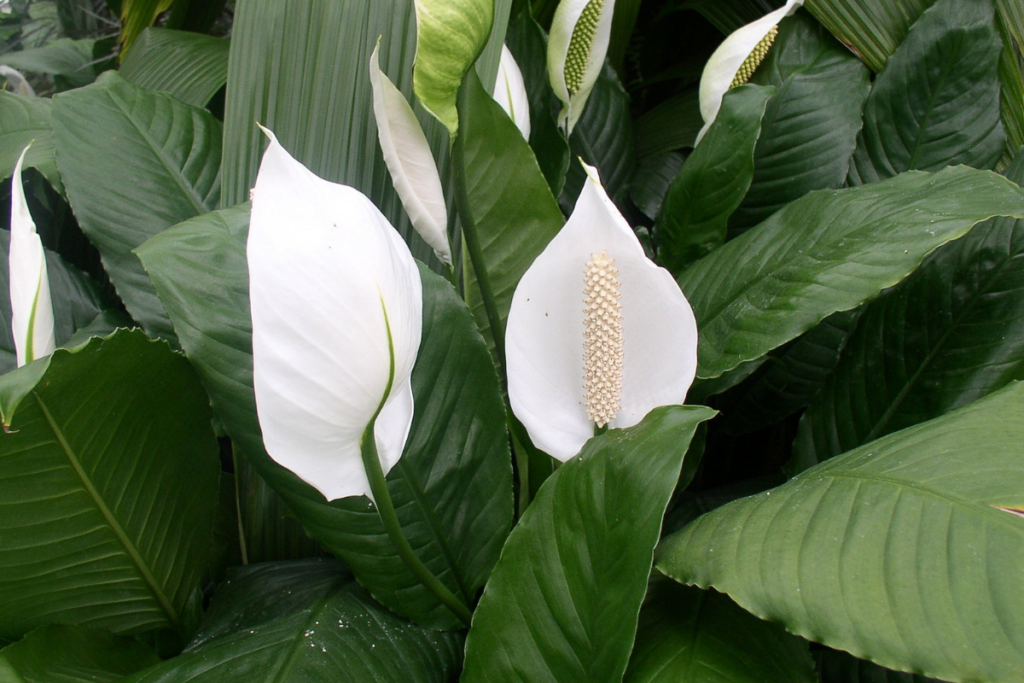
Giving a Peace Lily plenty of bright, indirect sunshine is the greatest approach to induce flowering. Throughout the growth season, it’s also essential to adequately water plants and to fertilize them with little but frequent dosages. Try to maintain the temperature and humidity above 65 degrees.
While you’re attempting to get your Peace Lily to blossom, keep in mind to use these essentials in moderation. Sunlight, water, and fertilizer are essential ingredients, but too much of a good thing may be harmful to your plant. Spathiphyllums shouldn’t be forced to blossom. Simply provide it with a setting where it may act normally.
Keep on reading to know more about peace lily flowering and more helpful tips.
Reasons Why Your Peace Lily Plant Is Not Blooming

When you purchase peace lily plants from nurseries and garden stores, they are almost typically juvenile plants that have been encouraged to blossom using gibberellic acid, a natural plant hormone in plants.
After being treated with gibberellic acid, it’s not unusual for newly planted peace lily plants to go for an extended period without blossoming; other times, it just takes some time before the plants begin to bloom on their own.
Your peace lily can also not be blooming for the following reasons:
- Inadequate Lighting
While peace lilies can withstand low light, strong, indirect light is significantly better for their ability to blossom. If you can, try transferring your plant to a location that gets at least 6 hours each day of indirect light.
- Inadequate Water
As peace lilies get dry, they will droop, alerting you that they need water. Deep water the plants at least once each week, and more often in the summer.
In the summer, you may also spritz the leaves with a spray bottle.
Read more about proper Peace Lily watering.
- Incorrect Temperature
Tropical plants like a peace lily grows best to temperatures between 65 and 86 degrees Fahrenheit for flowering (18 to 30 Celcius).
Place indoor peace flowers far from heaters and air conditioners.
RELATED: How To Revive A Dying Peace Lily: Essential Tips and Tricks
Tips to Encourage Peace Lily Flowering
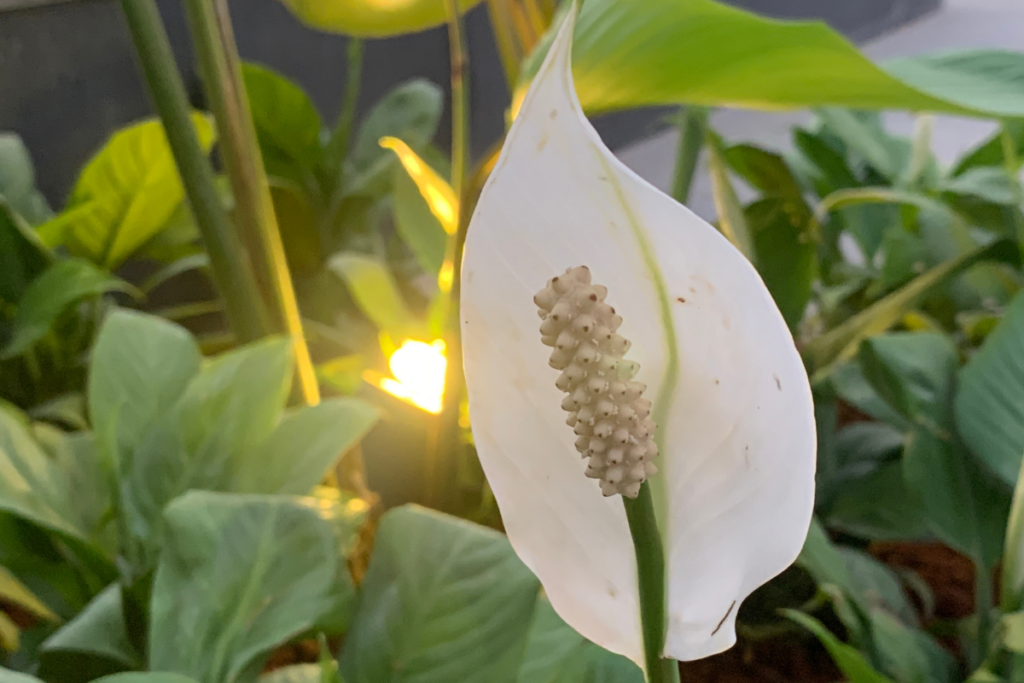
1. Wait For Maturity
Although not very fascinating, this one is sometimes essential. Peace lilies don’t bloom until they’ve reached a particular stage of development. They may reach that stage in around a year under the best growth circumstances. Nevertheless, circumstances aren’t always the best in indoor locations that aren’t tropical or greenhouses. A Spathiphyllum houseplant might sometimes take many years to grow.
A plant may not necessarily be fully developed simply because you see it blossoming in the shop. Gibberellic acid, a hormone spray, is often used by plant dealers to force Peace Lilies to blossom before plants are ripe.
This isn’t always harmful for the plant, but it could give you the erroneous impression about how flowery it can be. The plant could need a further year or two of development after the first blooms fade to produce more. Your Peace Lily is most likely too young to blossom if it can fit in a six-inch container.
2. Relocate Your Plant To A Brighter Location
One of the biggest myths about peace lilies is that they don’t need much sunlight to develop. Spathiphyllum is often included among the top low-light plants. If all you want is a compact foliage plant, that’s OK. Yet, you must expose your Peace Lily to the light if you desire blossoms.
Is it tucked away in a dim area of your office? Bring it up to the window a few feet. Is it located on a north-facing sill that is hidden by the structure next door? Place it in the next room’s east-facing window. Throughout the growth season, seek for a location that receives 6 to 8 hours of reasonably bright light every day.
Having said that, don’t expose your Peace Lily to the sun for more than two hours each day. You may soften the light by hanging some sheer curtains if the area you’re gazing at receives an excessive amount of direct sunlight, which happens often with windows facing south or west. Keep your plant healthy by putting at least five feet away from a southern exposure without any filters.
By observing the shadow your hand makes as it is held up, you may determine the quality of the light. Dark shadows with sharp edges are created by direct light; fuzzy edges are created by indirect light. Your Peace Lily generally won’t bloom if the shadows are too thin or lack any discernible form.
RELATED: Trimming or Pruning Peace Lily: How and Why Is It Important For Peace Lily Growth
3. Avoid Drying Your Plant Soil
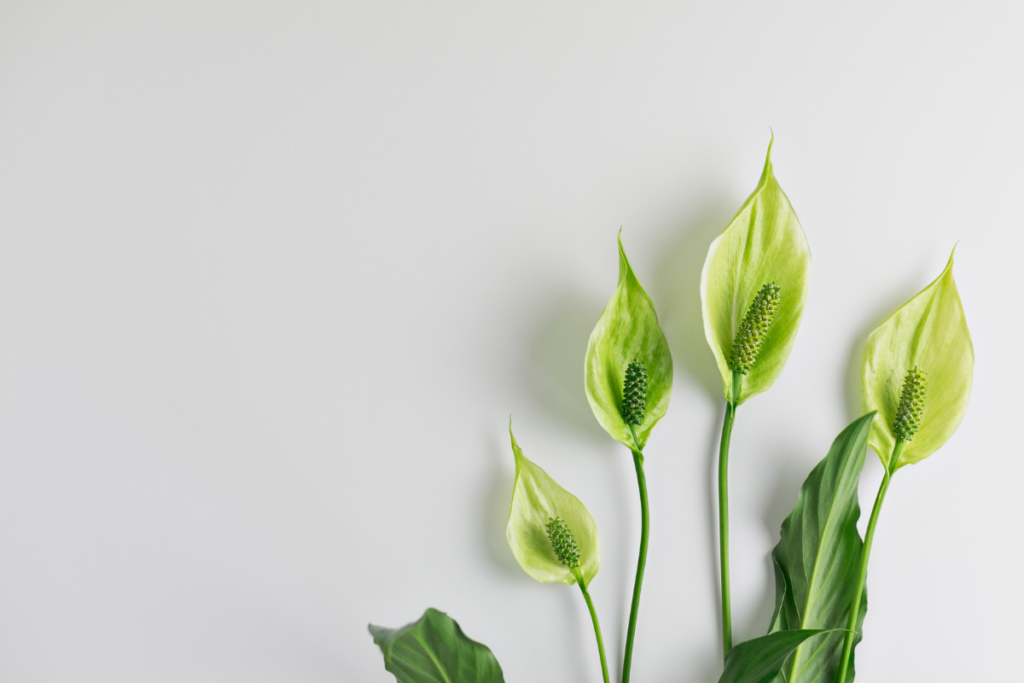
As their roots dry out, peace lilies often droop significantly. However, this has a good spin since it makes it simple to determine when a Spathiphyllum needs water.
Your Peace Lily requires water before it begins to sag. You endanger it if you allow it to dry out all the way to the roots. Your plant will have a considerably tougher time flowering as a result of that stress.
Every 2-4 days, you should use your finger to test the soil. Water Peace Lilies when the top inch of the potting mix becomes crumbly and dry. Moreover, give it a thorough sip. Ensure that the whole mass of soil is moistened to the point where the drainage pores underneath are running. Water is the most crucial component for a Peace Lily to blossom besides sunshine.
4. Ensure Warmth
Those who live in contemporary houses often find this one to be easy. In general, peace lilies and people like the same temperature settings. Nonetheless, warmth will be beneficial if you wish to increase the plant’s window for blooming. The ideal range for bloom production is between 65 and 68 degrees, particularly at night.
You must constantly choose a balanced strategy. A Spathiphyllum prefers temperatures between 85 and 90 degrees. Instead of tropical sunny temps, picture the temperature of a shaded jungle floor.
Even though the temperature in the room is generally comfortable, you should be aware of any isolated hot or cold regions. A Peace Lily that is too near to an air conditioner or heater won’t likely bloom.
5. Give Some Moisture
With Peace Lilies, humidity is often not a significant issue. They are, however, jungle-adapted, and too dry air may stress plants out to the point where blossoming is prevented. Check the humidity if your peace lily won’t blossom despite receiving plenty of light, water, and warmth.
Try to add a bit more moisture to the air if it’s below 50%. Placing your Peace Lily next to a bunch of different plants is one simple method to do this. In one region of your home, the water vapor they exhale may produce a little tropical or tropical-like zone. Another option is a pebble tray, such as the one we explain in this post.
If none of those solutions work, you may purchase a humidifier.
6. Put Some Fertilizer On Your Peace Lily
Be quite clear about what we are not stating in this sentence. Using houseplant fertilizer won’t make your Peace Lily bloom before it’s ready. More fertilizer does not always result in more and larger flowers.
The only thing fertilizer does is ensure that your Peace Lily has access to the nutrients it needs to produce blossoms. Potting soil lacks a consistent supply of decomposing organic matter that would replenish it with nutrients like calcium, phosphorus, and nitrogen. To keep it supplied, you require frequent fertilizer inputs.
With Peace Lilies, a little fertilizer goes a long way. Make use of a balanced recipe that may be diluted to a lesser concentration. During the growth season, apply a 1/4 to 1/2-strength treatment to your plant every 4-6 weeks. Around the middle to end of autumn, stop fertilizing. Your Peace Lily utilizes less nutrients when the days are too short for it to flourish, which raises the possibility of an undesirable accumulation.
You’ve definitely applied too much fertilizer if the leaves start to droop and turn brown at the tips right away after you fertilize. Let a sizable amount of water to gently trickle through the soil to rinse the minerals out of the pot.
7. Take Out Old Blooms
You want more from your Peace Lily than simply flowers. You would want for it to continue blooming as often as possible. Maintaining the circumstances we’ve outlined above helps in that. But when the flowers have finished blooming, it’s also wise to remove them.
Peace Lily blooms typically persist at least four weeks and sometimes continue to be a healthy plant for as long as two months. They will then begin to droop and become brown after that. Your Spathiphyllum will continue to expend energy caring for them even if they are essentially simply dead husks at that time. The next flower crop will now be delayed.
As soon as the blossoms begin to wrinkle and turn brown, clip them off. Use some 10% bleach, rubbing alcohol, or hydrogen peroxide to first sanitize your pruners. Finally, as near to the root as you can, cut the blossom and the stalk it is linked to off.
Read more about trimming and pruning peace lilies.
8. Divide Your Plant
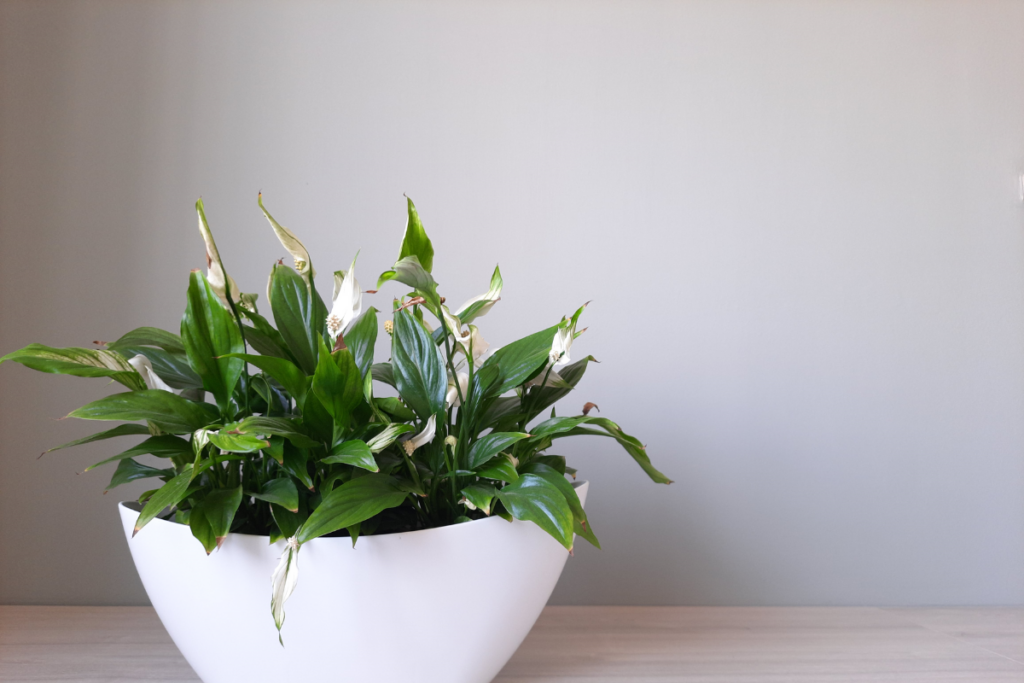
Owners of Peace Lilies for a long time should heed this tip. As they age, spathiphyllum plants can lose their inclination to blossom. This often occurs as a result of the abundance of new crowns of peace lily leaves that sprout up adjacent to the primary plant from the surrounding soil. Too many resources may be sucked up by these “babies” to allow the elder plant to flourish.
You may divide the younger plants and cultivate them individually to address this problem. Your Peace Lily may be easily uprooted, then the new crown and roots are separated at that point. Often, you may just use your hands to pull the two parts apart.
Each Peace Lily should be placed in a fresh container with well-aerated soilless potting soil. Keep the humidity high and avoid exposing the transplants to direct sunshine for the following several weeks. Be very cautious not to overwater until you see new leaves emerging.
Soon, your original plant ought to begin flowering once again. Then after a year or two of development, the new ones will start to blossom.
Keep on reading about Peace Lily repotting.
RELATED: Peace Lily: Top Reasons Why They Droop and How To Fix Them
Frequently Asked Questions
Why are the blossoms on my peace lily green?
When the blooms initially open, they often have a greenish tint before becoming completely white. The dying blossoms will first become green or yellow before becoming brown. Overfertilizing the plants may also result in green peace lily blossoms.
Throughout the spring and early summer, it’s recommended to fertilize peace lilies every few months; however, because the plants aren’t actively developing in the winter, you should avoid fertilizing them then. It’s preferable to place your peace lily away from direct sunshine since peace lily blossoms may also turn green from too much sunlight.
Can you eat peace lily flower?
A peace lily’s flower may induce nausea, skin irritation, a burning feeling in the mouth, and trouble swallowing in people and dogs if they are consumed.
Can a peace lily be replanted while it is in bloom?
While peace lilies don’t mind being little root-bound, you should relocate the plant to a larger container if you see roots coming out the bottom. Repotting peace lilies is best done in the springtime, and if you’re careful with the roots, the plant will continue to bloom in its new container.
What season do peace lilies bloom?
Peace lily plants in good health will bloom twice a year, once in the spring and once in the autumn. Prior to turning brown, the flowers often remain in bloom for one to two months.
Final Thoughts
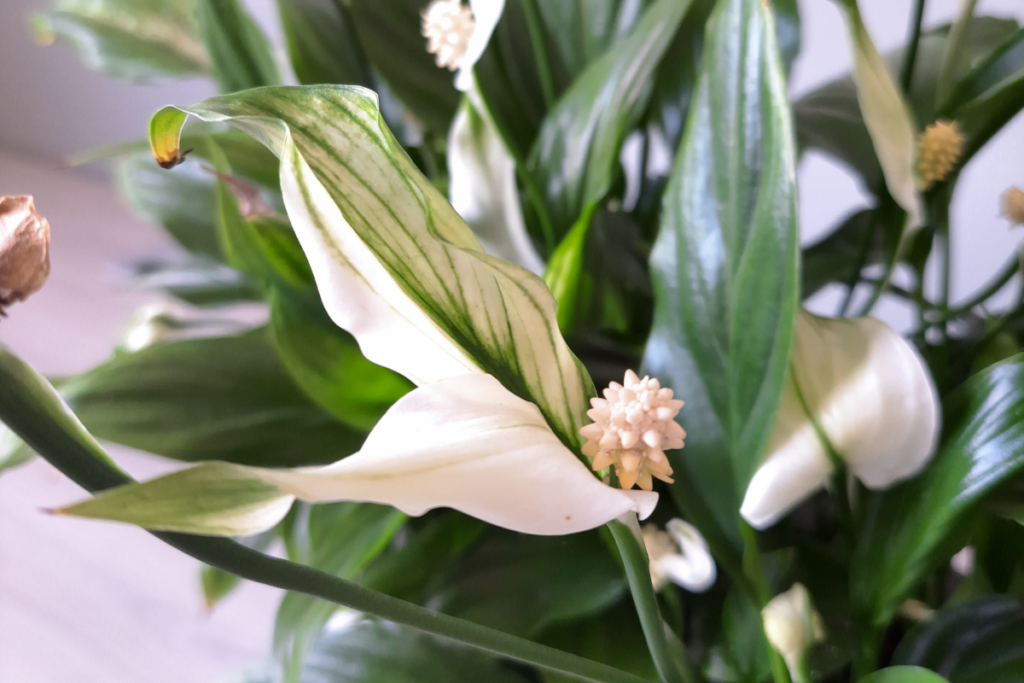
There is no assurance that a Peace Lily outside of its native habitat circumstances will flower, not even with the utmost care and attention. Yet doing these actions will significantly improve your odds.
And even if they don’t bloom once more, you can still take advantage of their glossy foliage and minimal care requirements all year long.
A peaceful lily in bloom is a contented peaceful lily. Your plant should produce an abundance of beautiful flowers when it is in a situation that plays to its strengths. We hope that the beauty queen your Peace Lily was destined to be will happen with this article.
That’s my tips and tricks to get more peace lily flowers. Make sure to check out our other articles:
15 Breath-taking Types Of Calathea For Your Private Tropic Corner
9 Stunning Rare Philodendrons; With Tips To Help Them Thrive
The 28 Most Gorgeous Alocasia Types You Can Grow In Your Homes







